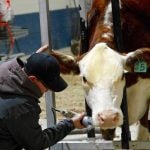It had been two weeks since Ken Kennedy had last seen his cattle, which were grazing on community pasture about 32 kilometres from his farm near Dawson Creek, B.C.
“When I did go up there, I found all hell had broken out. Dead cows all over the place.”
At first he saw two calves lying bloated and upside down about two metres apart.
“I thought, ‘Well, they’ve ate some larkspur or something.'”
A few minutes later he found another seven dead calves and immediately pulled out his cell phone to locate the veterinarian. He couldn’t find the vet but he got in touch with a local cattle buyer who told Kennedy he was looking at a blackleg outbreak.
Read Also

Trump cuts off trade talks with Canada
(Reuters) – U.S. President Donald Trump said on Thursday that all trade talks with Canada were terminated following what he…
In the next few days friends and neighbors helped Kennedy round up what remained of his herd for treatment and vaccination against the devastating disease. He lost about 75 February and March calves to blackleg.
“I don’t know why I didn’t (vaccinate earlier),” said Kennedy, who carried no insurance.
“We got careless because we haven’t even thought about it for 25 years.”
Veterinarian Barry Ross said blackleg has affected about 15 herds in the Dawson Creek area, but none as bad as Kennedy’s.
“Vaccinations started to get lax, so then you have a susceptible population and that’s kind of what’s happening.”
Ross doesn’t know where the blackleg first occurred or how it is spreading, but an aggressive vaccination and treatment program should prevent it from claiming more cattle in the area.
“Anyone who hasn’t vaccinated basically has it done now.”
The disease primarily affects calves between two and six months old and is treatable if caught early.
“If you give them aggressive penicillin therapy then many will respond and we’ve saved many of them.”
Ross said about 100 calves in the area have died from the disease, which was first diagnosed in February.
District agriculturist Jim Forbes thinks dry conditions in the Dawson Creek area can be blamed for the outbreak.
“This has exposed some formerly wet lands to grazing this year. That’s a likely source of the blackleg spores getting into the herds,” said Forbes.
“The animals are into some areas that they’re not normally into. They could be exposed to more bare soil that can cause the problem.”
Forbes also has an explanation for why producers are not vaccinating cattle against blackleg. Many no longer brand their cattle and branding time is when many animals were routinely vaccinated.
For a producer like Kennedy whose cattle are in a large pasture with lots of bush, it’s inconvenient to round up the calves for an injection.
But that’s about to change.
“I suspect we won’t have too many unvaccinated animals in the area for quite a few years,” said Forbes.















